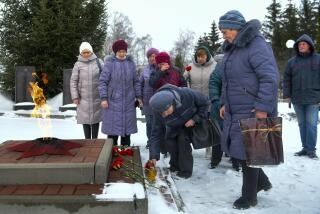Russians Find Same Explosive in the Wreckage of Both Planes
- Share via
MOSCOW — Residue of the same type of explosive found in the wreckage of one of two Russian airliners that crashed last week has been found in the second, authorities said Saturday.
“Traces of hexogen were found in the course of an additional investigation of fragments of the Tu-134 airplane that crashed in the Tula region,” Sergei Ignatchenko, a spokesman for the Federal Security Service, or FSB, told the Russian news agency Interfax.
The FSB, the main successor to the KGB, announced Friday the discovery of traces of hexogen in the wreckage of the other plane, which crashed in the Rostov region in southern Russia. Ninety people died in the crashes after both jets took off from the same Moscow airport Tuesday night.
Investigators’ suspicions appeared to be focused on two women with Chechen-sounding surnames -- one believed to have been on each flight -- as possible suicide bombers. Authorities have said that no one has come forward to claim either body and that both women booked seats shortly before departure.
Of the 44 people killed in the Tu-134 crash, 43 bodies have been positively identified, and body parts of the last person -- a woman -- have been sent to Moscow for identification and examination to find out whether there are traces of explosives, the news agency Itar-Tass reported. That woman is believed to be Amanta Nagayeva, who was on the passenger list for the flight to the southern city of Volgograd, which crashed about 100 miles south of Moscow.
In a further indication that at least one of the women might have been a suicide bomber, the newspaper Izvestia reported Saturday that Nagayeva’s brother had been seized by Russian forces in war-torn Chechnya about three years ago.
Human rights organizations say Russian troops in Chechnya have a history of abducting suspected rebels or rebel supporters and executing them. Russian media have coined the term “black widows” to describe the women who have become suicide bombers after losing husbands, brothers or fathers in the Chechnya fighting.
Chechens exercised self-rule in their Caucasus republic after defeating Russian troops in a 1994-96 war. Russian forces returned in 1999 and have fought guerrillas since. There had been fears that rebels might launch attacks before today’s election there to replace the pro-Kremlin president, who was assassinated in May. A Moscow-backed candidate is expected to win.
Nagayeva and the woman whose body remained unclaimed from the other crash -- identified only as S. Dzhebirkhanova -- might not be ethnic Chechens but rather come from a small ethnic group in Chechnya known as Nogai, the newspaper Moskovsky Komsomolets reported Saturday. Izvestia reported that both women lived in Chechnya.
FSB spokesman Ignatchenko also said Saturday that on orders from President Vladimir V. Putin, Russia’s strict airport security procedures would be further tightened in an effort to meet the highest international standards.
“In particular, it is planned to use the checking and flight security control system that is used in Israel and is considered the most effective in the world,” he said.
Until now, the inquiry into the crashes has been formally considered a criminal investigation, but prosecutors are considering reclassifying it as “a terrorism case,” Ignatchenko told Interfax.
More to Read
Sign up for Essential California
The most important California stories and recommendations in your inbox every morning.
You may occasionally receive promotional content from the Los Angeles Times.










